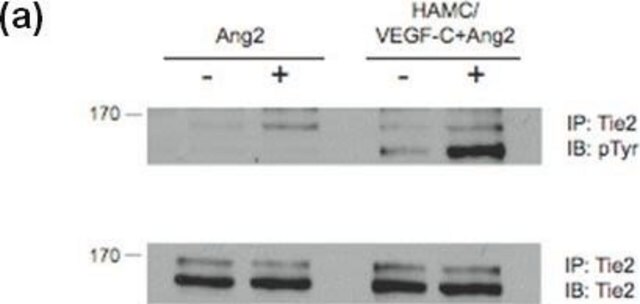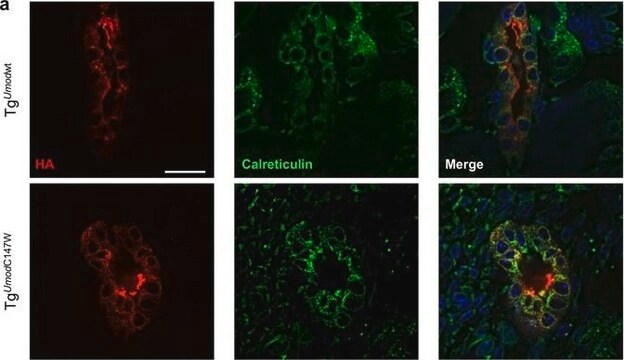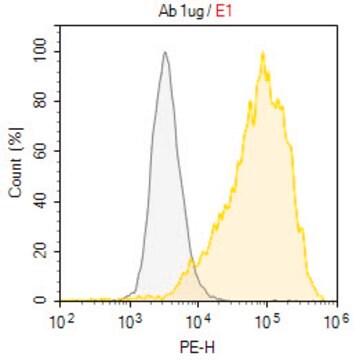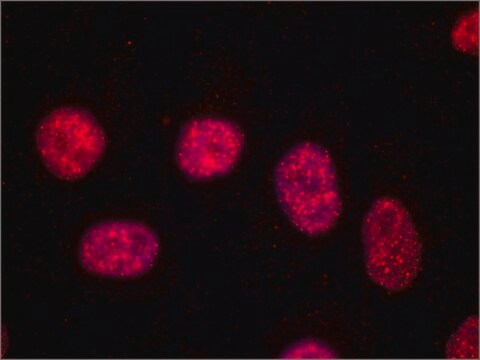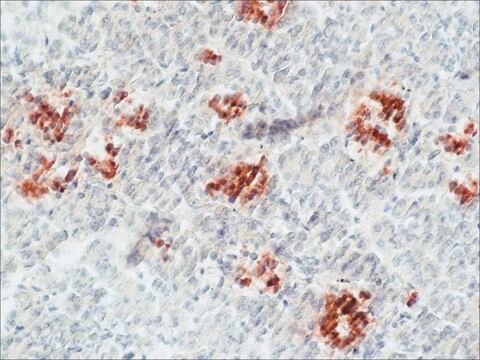推薦產品
生物源
mouse
品質等級
共軛
unconjugated
抗體表格
purified immunoglobulin
抗體產品種類
primary antibodies
無性繁殖
HAP46.5, monoclonal
形狀
buffered aqueous solution
分子量
antigen ~25 kDa
物種活性
canine, mouse, rat, chicken, human
技術
indirect ELISA: suitable
microarray: suitable
western blot: 0.5-1 μg/mL using total cell extract of human MCF7 breast carcinoma cells
同型
IgG1
UniProt登錄號
運輸包裝
dry ice
儲存溫度
−20°C
目標翻譯後修改
unmodified
基因資訊
human ... HMGB1(3146)
mouse ... Hmgb1(15289)
rat ... Hmgb1(25459)
一般說明
High-mobility group-1 protein (HMG-1) or amphoterin is a nuclear DNA-binding protein that facilitates the bending and transcription of DNA. It also has a pivotal role in the regulation of chromatin structure, DNA replication, ligation and repair. Monoclonal anti-HMG-1 antibody can be used as a vital tool to study the biology of transcription. It can also be used in indirect ELISA and immunoblotting (25kD approx.). Mouse anti-HMG-1 antibody reacts specifically with HMG-1 of canine, mouse, chicken, rat and human.
Monoclonal Anti-HMG-1 (mouse IgG1 isotype) is derived from the HAP46.5 hybridoma produced by the fusion of mouse myeloma cells and splenocytes from BALB/c mouse immunized with purified human recombinant HMG-1. HMG-1 (High-Mobility-Group protein, amphoterin) is a highly conserved protein with more than 95% amino acid identity between rodent and human HMG-1. It is a prevalent non-histone chromatin component and a non-sequence specific DNA binding protein. HMG-1 consists of two homologous HMG boxes rich in basic amino acids and an acidic tail at the carboxy-terminus.
免疫原
purified recombinant human HMG-1.
應用
Monoclonal Anti-HMG-1 antibody is suitable for use in immunochemical applications such as ELISA and immunoblotting (approx. 25 kDa).
Monoclonal anti-HMG-1 antibody can be used in immunofluorescent staining. It can also be used in microarray and western blotting.
生化/生理作用
High-Mobility-Group protein, amphoterin, HMG-1 is involved in the regulation of chromatin structure as well as being involved, either as positive or negative factors with various aspects of DNA replication, transcription, repair, and ligation. HMG-1, identified as a membrane associated protein termed “amphoterin,” mediates neurite outgrowth, tumor outgrowth, and metastasis. It participates in plasminogen activation and is recognized as a late mediator of endotoxin lethality in mice.
適合性
Monoclonal Anti-HMG-1 recognizes human, canine, mouse, rat, and chicken HMG-1.
外觀
Solution in 0.01 M phosphate buffered saline containing 15 mM sodium azide.
免責聲明
Unless otherwise stated in our catalog or other company documentation accompanying the product(s), our products are intended for research use only and are not to be used for any other purpose, which includes but is not limited to, unauthorized commercial uses, in vitro diagnostic uses, ex vivo or in vivo therapeutic uses or any type of consumption or application to humans or animals.
未找到適合的產品?
試用我們的產品選擇工具.
儲存類別代碼
10 - Combustible liquids
水污染物質分類(WGK)
nwg
閃點(°F)
Not applicable
閃點(°C)
Not applicable
個人防護裝備
Eyeshields, Gloves, multi-purpose combination respirator cartridge (US)
The double life of HMGB1 chromatin protein: architectural factor and extracellular signal
Muller S, et al.
The Embo Journal, 20(16), 4337-4340 (2001)
Xiaoping Qing et al.
Immunology letters, 121(1), 61-73 (2008-09-30)
Although anti-DNA antibodies have been decisively linked to the pathogenesis of lupus nephritis, the mechanisms have not been conclusively determined. Recently, we reported that anti-DNA antibodies may contribute to kidney damage by upregulation of proinflammatory genes in mesangial cells (MC)
Non-histone nuclear factor HMGB1 is phosphorylated and secreted in colon cancers
Kang HJ, et al.
Laboratory Investigation; a Journal of Technical Methods and Pathology, 89(8), 948-948 (2009)
HMG1 protein stimulates DNA end joining by promoting association of DNA molecules via their ends
Muller S, et al.
European Journal of Biochemistry, 267(13), 4088-4097 (2000)
Jing Xie et al.
Molecular medicine reports, 13(6), 5335-5341 (2016-04-29)
High mobility group box 1 (HMGB1) protein serves an important role in myocardial ischemia/reperfusion (I/R) injury. MicroRNAs (miRNAs) are a group of small non‑coding RNAs that regulate numerous signaling pathways involved in myocardial I/R injury. The present study aimed to investigate whether
我們的科學家團隊在所有研究領域都有豐富的經驗,包括生命科學、材料科學、化學合成、色譜、分析等.
聯絡技術服務
